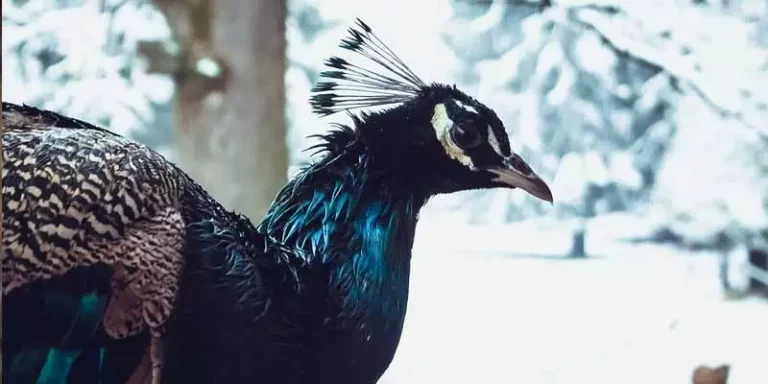Peacocks are one of the most popular birds in the world. They can live in all sorts of climates, and they’ve even been found in cold areas. But is it safe for peacocks to live in cold weather? Do they have the proper resources to survive?
This blog article looks at the evidence and finds out if peacocks can live comfortably in cold weather.
Can Peacocks Live In Cold Weather?
Peacocks do not hibernate like other animals because they can survive in the winter. Peacocks have several ways to survive in cold weather. They just need to avoid getting too cold.
Peacocks are able to regulate their body temperature by fluffing up their feathers and spreading out their wings.
Another way to keep warm is that they have a special organ called the preen gland, which secretes a film of oil over their feathers. The oil is used to keep their feathers clean and healthy. It also will help keep the heat from escaping through their feathers.
In addition, they have a layer of fat that they build up to help them stay warm during the winter.
How Do Peacocks Stay Warm In The Winter?
Peacocks use their feathers, beaks, and other physical features to regulate their body temperature. When the weather is cold, they use these features to keep themselves warm.
Additionally, they may also use their yellow beak to attract mates or food.
Peacocks use a variety of feathers to keep their body warm. They have several types of feathers that they use to keep warm: the down feather, the primary feather, and the secondary feather.
The down feather is the most common type of feather used by peacocks. It’s a small, thin piece of hair that is located on the neck and back. When it’s cold outside, peacocks will put down their down feather to keep themselves warm.
The primary feather is also used when it’s cold outside. It’s a larger, stronger feather that is located on the chest and head.
The secondary feather is a smaller, weaker feather that is located on the tail. These feathers are used together to create a fan. The fan helps circulate air around the bird and keeps them warm.
How To Care For Peacocks During The Winter
Peacocks can be difficult to care for during the winter months because of their need to be outside in order to avoid frostbite and hypothermia. There are many ways to care for peacocks during the winter.
Some of these include:
– Providing them with a heated area to live in. Peacocks are very susceptible to the cold, so they need to be kept warm during the winter. You can put hay in their cage to help insulate it. The enclosure should also be large enough for the peacock to stretch its wings out fully.
– Give them a warm drink of water every day. You can install a water heater bowl in their cage. This will prevent the water from freezing.
– Providing them with food that is specially designed for peacocks. They need to be fed with a mixture of millet, corn, wheat, and rice in order to keep them warm during winter.
– Keeping the enclosure clean. The enclosure should be clean at all times. During the winter, peacocks may spend most of their time in the enclosure. If it’s dirty, it’s likely will start to have harmful bacteria growing due to their waste.
What Do Peacocks Eat During The Winter?
During the summer, food is readily available for peacocks. They will forage for food and since they are omnivores, they will eat just about anything they find that’s edible.
However, during the winter, food will be scarce and it will be hard for them to forage for food. The peacocks eat a variety of food during the winter including worms, insects, berries, and leaves.
Therefore, it’s a good idea to provide your peacocks with plenty of food, especially those that are high in protein. This can include foods like raisins, figs, lettuce, and worms.
Conclusion
Peacocks are able to survive in colder climates than most birds because of their feathers and ability to regulate their body temperature through heat exchange with the environment. Their feathers are made with a layer of hollow quills that trap air and insulate the bird from the cold.
However, they can be affected by frostbite if they get too cold. You will need to prepare them for the winter by insulating their enclosure, providing them with plenty of food, and keeping them clean.


